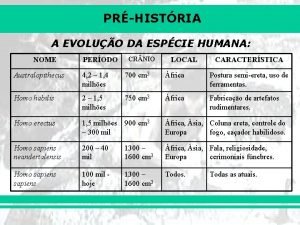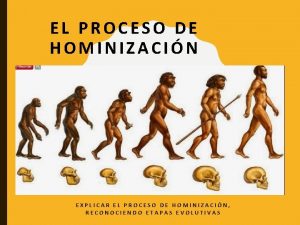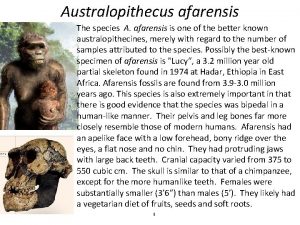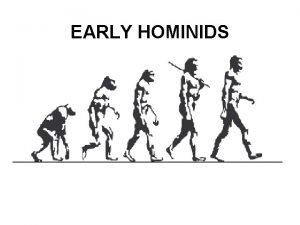Australopithecus afarensis The species A afarensis is one






- Slides: 6

Australopithecus afarensis The species A. afarensis is one of the better known australopithecines, merely with regard to the number of samples attributed to the species. Possibly the best-known specimen of afarensis is "Lucy“, a 3. 2 million year old partial skeleton found in 1974 at Hadar, Ethiopia in East Africa. Afarensis fossils are found from 3. 9 -3. 0 million years ago. This species is also extremely important in that there is good evidence that the species was bipedal in a human-like manner. Their pelvis and leg bones far more closely resemble those of modern humans. Afarensis had an apelike face with a low forehead, bony ridge over the eyes, a flat nose and no chin. They had protruding jaws with large back teeth. Cranial capacity varied from 375 to 550 cubic cm. The skull is similar to that of a chimpanzee, except for the more humanlike teeth. Females were substantially smaller (3’ 6”) than males (5’). They likely had a vegetarian diet of fruits, seeds and soft roots.

Australopithecus boisei Specimens attributed to A. boisei have been found mostly in Ethiopia, Tanzania, and Kenya in East Africa. Boisei had large and extremely powerful jaws with a sagittal crest along the top of their skulls. These adaptations allowed them to feed on hard low-quality foods like hard roots and nuts. Because of this it has been given the nickname “nutcracker man”. A. boisei existed between 2. 1 and 1. 1 million years ago. It was similar to robustus, but the face and cheek teeth were even more massive, some molars being up to 2 cm across. The brain size is very similar to robustus, about 530 cubic cm. A few experts consider boisei and robustus to be variants of the same species. Australopithecus robustus and boisei are known as robust australopithecines, because their skulls in particular are more heavily built. They have never been serious candidates for being direct human ancestors. This lineage may have died out due to overspecialization to a specific environment, and when the environment changed, evolution could not keep up.

Homo habilis H. habilis is nicknamed the "handy man“. This is because it was the first hominid with fossil evidence of tools found with its remains. Its diet included some meat but mostly vegetation. Habilis existed between 2. 4 and 1. 5 million years ago. It has some similarities to australopithecines. The face is still primitive, but it projects less than early Australopithecines. The back teeth are smaller, but still considerably larger than in modern humans. The average brain size, at 650 cubic cm, is considerably larger than in australopithecines. Brain size varies between 500 and 800 cubic cm. The brain shape is also more humanlike. It may have had the capability of basic speech. Habilis is thought to have been about 5’ and about 100 lbs in weight, although females may have been smaller. Habilis has been a controversial species. Originally, some scientists did not accept it as its own species, believing that all habilis specimens should be assigned to either the australopithecines or Homo erectus. Habilis is now fully accepted as a species, but it is widely thought that the 'habilis' specimens have too wide a range of variation for a single species, and that some of the specimens should be placed in one or more other species.

Homo erectus H. erectus existed between 1. 8 million and 300, 000 years ago. Like habilis, the face has protruding jaws with large molars, no chin, thick brow ridges, and a long low skull, with a brain size varying between 750 and 1225 cubic cm. Early erectus specimens average about 900 cubic cm, while late ones have an average of about 1100 cubic cm. The skeleton is a little more robust than those of modern humans, but still very similar. Their diet was varied but did include some meat. Studies of skeletal fossils indicates that erectus may have been more efficient at walking than modern humans, whose skeletons have had to adapt to allow for the birth of larger-brained infants. Erectus is the first hominid with evidence of migrating out of Africa. Homo habilis and all the australopithecines are found only in Africa, but erectus was wide-ranging, and has been found in Africa, Asia, and Europe. There is evidence that Erectus probably used fire and their stone tools are more sophisticated than those of habilis.

Homo neanderthalensis Neanderthals existed between 230, 000 and 30, 000 years ago. The average brain size is slightly larger than that of modern humans, about 1450 cubic cm, but this is probably correlated with their greater bulk. Like erectus, they had a protruding jaw and receding forehead. The chin was usually weak. The midfacial area also protrudes, a feature that is not found in erectus or sapiens and may be an adaptation to cold. Neanderthals mostly lived in cold climates, and their body proportions are similar to those of modern coldadapted peoples: short and solid, with short limbs. Men averaged about 5'6" in height. Their bones are thick and heavy, and show signs of powerful muscle attachments. Neanderthals would have been extraordinarily strong by modern standards, and their skeletons show that they endured brutally hard lives. A large number of tools and weapons have been found, more advanced than those of Homo erectus. Neanderthals were very good hunters, that relied heavily on meat in their generalized diet. They were the first people known to have buried their dead, with the oldest known burial site being about 100, 000 years old. They are found throughout Europe and the Middle East.

Homo sapiens Modern forms of Homo sapiens first appear about 120, 000 years ago in East Africa. They have a generalized omnivore diet. Modern humans have an average brain size of about 1350 cubic cm. The forehead rises sharply and eyebrow ridges are very small. About 40, 000 years ago, tool kits started becoming more sophisticated, using a wider variety of raw materials such as bone and antler, and containing new implements for making clothing, engraving and sculpting. Fine artwork, in the form of decorated tools, beads, ivory carvings of humans and animals, clay figurines, musical instruments, and spectacular cave paintings appeared over the next 20, 000 years. They migrated across the globe and into the Americas by about 12, 000 years ago Even within the last 100, 000 years, the long-term trends towards smaller molars and decreased robustness can be measured. The face, jaw and teeth of 30, 000 year old humans are about 20 -30% more robust than ours. Interestingly, some modern humans (aboriginal Australians) have tooth sizes more typical of early sapiens. The smallest tooth sizes are found in those areas where food-processing techniques have been used for the longest time.











